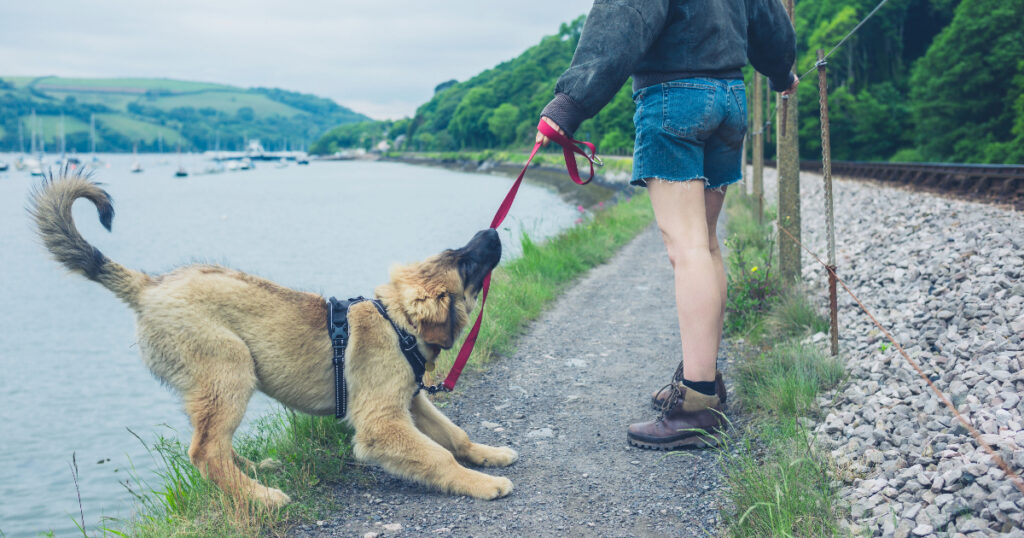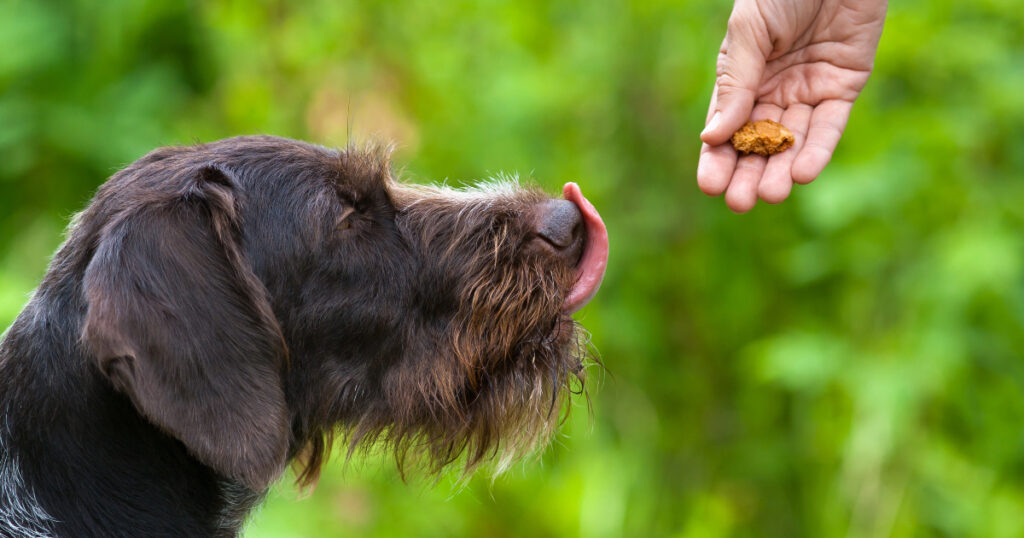Taking your dog for a walk should be an enjoyable experience for both of you. But if your dog is constantly pulling on the leash, it can quickly become frustrating and unpleasant. Teaching your dog to walk calmly on a loose leash takes time and consistency, but it’s an important skill that benefits you both. In this comprehensive guide, you’ll learn positive training techniques to stop your dog from pulling, set them up for success, and help them become a polite walking companion.
With the right tools and methods, you can transform those tug-of-war leash walks into relaxing strolls with your well-behaved best friend. Let’s get started on the path toward happy walks together.
Use the Right Equipment to Stop Your Dog from Pulling
Choosing the right leash and collar or harness can make a huge difference in controlling your dog’s pulling. A regular flat collar puts all the pressure on your dog’s sensitive neck when they pull. Instead, try using a front clip harness. The leash attaches to a ring on the dog’s chest, which turns its body around when it tries to pull forward. This gives you more control without causing them discomfort. Make sure the harness fits well so they can’t slip out of it.
You can also try a head halter, which fits over your dog’s nose and under its chin like a horse halter. Since it attaches under their chin, you have even more control over directing their head. Introduce it slowly at home first so your dog can get used to the strange feeling. Give them treats for just putting their nose through it at first. Attach a backup leash to a regular collar or harness too, for safety in case the head halter comes off.
Some people find bungee leashes help absorb the force of pulling, but for strong pullers, a regular 6-foot leash tends to work better. The right equipment can give you power steering and stop the opposition reflex where your dog just pulls harder when they feel resistance.
Use Your Movement to Control Your Dog’s Pulling

Your movement and body language are powerful tools to stop your dog from pulling. You have to teach them that pulling gets them nowhere, but walking politely beside you keeps the walk moving.
As soon as your dog starts pulling, stop immediately and stand totally still until they take a step back and the leash becomes loose. You may have to do this over and over, but be patient and consistent. Your dog will figure out they only get to move forward again when the leash is loose.
You can also suddenly turn and walk the other way when they start pulling. This forces them to turn around and follow you. Use an upbeat, excited voice when you turn to motivate them to follow along with you. After a few steps, turn back around and continue in your original direction.
Varying your speed, doing figures of eights, and turning in circles keep your dog focused on you because they never know what you’ll do next. The more interesting and unpredictable you are, the more incentive they have to pay attention and walk politely beside you.
Use Treats to Reinforce Good Leash Manners

You have to show your dog that walking nicely next to you really pays off. Bring high-value treats like bits of hot dog, cheese, or chicken on every walk. Reward them with treats whenever the leash is loose. This teaches them that having a loose leash is a good thing.
You can also use treats to lure your dog into the proper heel position at first. Hold treats by your leg and reward them for staying in position. Starting inside your home or yard allows you to teach them without distractions first. Once they understand the concept, start bringing treats on real walks to continue reinforcing the training.
The better you make your dog feel for walking politely on a loose leash, the more likely they are to repeat that behavior. Be sure to bring enough treats – running out in the middle of training means you lose your incentive. Consider wearing a treat bag or fanny pack to hold everything.
Start Leash Training in a Low Distraction Area
Trying to teach loose leash walking in an exciting environment stacks the odds against you and your dog. Start your training sessions in your house or backyard, free of distractions. Once your dog has the basic idea, graduate to quiet streets with minimal activity.
You can also pick times of the day when things tend to be calmer, like early mornings or evenings. Your dog will be less stimulated and excitable during off-peak hours. Setting your dog up for success by keeping distractions low in the beginning prevents frustration for both of you.
An out-and-back route is better than a circular one at first. Many dogs do better maintaining their training on the way home since the route is now familiar territory. Once your dog consistently walks properly in low-distraction areas, you can challenge them in progressively more exciting locations. Go slowly to keep it a positive experience.
Exercise Your Dog Before Leash Training Sessions

While exercise is one benefit of walks, that is not the point of initial training sessions. First, you need to teach polite leash manners without your dog being so excited they can’t focus. Starting with a dog who already has its edge taken off sets you both up for success.
Play fetch in the yard or walk up and down stairs before your training session. A slightly tired dog is more likely to pay attention and retain what they are learning. You can meet their exercise needs fully once they reliably walk without pulling.
This tip is doubly important for high-energy dogs prone to excitability and zoomies. Get some of that pent-up energy out before asking them to walk calmly next to you. You’ll both enjoy the process a lot more.
Be Patient and Consistent with Your Training
Changing your dog’s pulling takes time and dedication. The longer they have been doing it, the more effort it will take to alter the habit. Stick with it and you will see progress. If one method doesn’t seem to work for your dog, try another. Not all techniques work perfectly for every dog.
You need to be as consistent as possible with the training so your dog understands exactly what you want from them. Have everyone who walks your dog follow the same rules and commands. For example, decide if you want them walking on your left or right and stick with it.
It can take months of regular practice before your dog reliably walks without pulling. But the resulting relaxed strolls with your dog are incredibly rewarding. Don’t get discouraged if it feels slow going. Persistence and consistency pay off when training your dog.
Why Dogs Pull and How to Avoid Encouraging It
Dogs naturally walk much faster than humans, so having to stroll slowly beside you is tough self-control for them. They are excited to be out exploring the sights and smells. Pulling gets them where they want to go more quickly.
You may accidentally encourage pulling without realizing it. Any time your dog manages to move forward while pulling, it rewards the behavior and reinforces it. They learn that pulling works.
Instead of pulling your dog along, turn and walk in the other direction when it starts to pull. This takes the reward out of the equation. If you never allow them to get where they want to go while pulling, they have no incentive to keep doing it.
It’s also important not to unintentionally pull your dog, which seems to encourage pulling back. Let your dog follow along and steer themselves rather than constantly yanking their leash. The simple rule is: don’t pull your dog if you don’t want them to pull you.
Be Prepared for Leash Training Challenges
Don’t expect your dog to become perfect at leash walking overnight. For many dogs, this takes weeks or months of dedication and hard work from you. But it is a worthwhile investment that makes your daily walks pleasurable quality time together.
Some dogs get so excited and stimulated on walks they temporarily forget their training. Be patient and gently get them back on track without scolding them. Always set them up for success by starting walks in quiet areas before heading to busier locations.
If you need to pop out quickly with no time for full training, consider having two harnesses – one they know means it’s okay to pull just this once, and one for your regular training. This allows you to maintain your overall progress.
Any dog can learn to walk properly on a leash with the right techniques and equipment. Stick with positive reinforcement methods to get results while deepening your bond. The effort leads to relaxing, happy walks with your well-behaved companion by your side.
Ask For Help from Trainers if Needed
Some cases of pulling require additional help beyond basic training. If your dog is very powerful or reactive and you cannot control their pulling, consult a professional trainer. They can assess if your dog needs more advanced methods or equipment.
For dogs who get very excited and lunge or bark at distractions, personalized one-on-one training is invaluable. A knowledgeable trainer can pinpoint why your dog reacts this way and design a customized training plan. Whether they are fearful or just overly stimulated, professional support gets to the root of the issue.
Do not use punishment, choke chains, or shock collars to address pulling issues. This will only make your dog’s anxiety or frustration worse. Positive reinforcement training creates trust and better leash manners. Your whole family will enjoy walking with your dog.
Stay Consistent for the Best Results
While loose-leash walking takes dedication and hard work, it is an extremely worthwhile investment. You need to be as consistent as possible with your training cues, techniques, boundaries, and equipment. This allows your dog to fully understand the rules and expectations.
If your dog manages to pull and get where they want to go sometimes but not others, they become confused and frustrated. Set your dog up for success by committing to consistency with their training. It takes time and effort, but the resulting relaxed daily walks are priceless.
Dogs thrive when they clearly understand what is expected of them. Stay positive yet firm and be consistent with your training approach. Your dog will make excellent progress with regular practice and reinforcement. Keep your chin up through temporary setbacks – you’ve got this!
FAQ
Q: Why does my dog pull more on the way home from our walk?
A: Many dogs pull more heading home because they are already familiar with the route after investigating it thoroughly on the way out. They are more excited to get home once they’ve already explored the walk.
Q: Should I use a choke chain to stop my dog from pulling?
A: No, choke chains and prong collars cause pain and should never be used. They create anxiety and can worsen your dog’s behavior. Always stick to positive reinforcement.
Q: What if my dog only pulls sometimes during our walk?
A: Be patient and gently get them back on track with your training. Use high-value treats to regain their focus. Expect setbacks and inconsistencies as you continue practicing loose-leash walking.
Conclusion
With dedication and positive reinforcement, you can teach even an enthusiastic puller to walk properly on a leash.
Arm yourself with patience and be consistent. It may take weeks or months, but your hard work will pay off.
Focus on setting your dog up to succeed and making the experience rewarding for them. Proper leash walking takes daily practice, but the resulting relaxed time together is priceless.
You and your dog will both appreciate the effort. Never hesitate to seek professional help from a qualified trainer if needed.
But with persistence and compassion using force-free methods, you can do this.
Soon you’ll be enjoying meandering walks around the neighborhood with your well-trained canine companion happily trotting alongside you.

